Posted by Elena del Valle on October 25, 2017
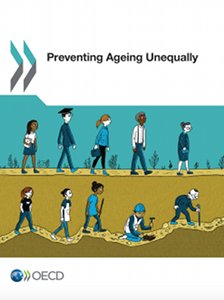
Preventing Ageing Unequally
Photos: Organisation for Economic Co-operation and Development
In the United States, employment among the prime working age population is lower now than it was in 2000, according to the Organisation for Economic Co-operation and Development (OECD). In 2000, 82 percent of 35 to 44 year old men and women worked. By 2016 only 79 percent of them worked. It is one of few countries studied by the organization where that is the case, leading researchers to conclude that is one of the main reasons for the growth of inequality.
In Preventing Ageing Unequally, a 256-page report the OECD released recently, representatives from the Paris based organization suggest that ensuring more people work for more years may result in higher retirement incomes in the future. Data in the report, which is available for online purchase as a PDF file for $42, indicate that more than four-fifths of the highly educated working age population have a job, but only about half of those with low education levels are employed.
According to the report summary, income disparities among today’s young and prime age adults are significantly higher than they were among the Baby Boomers when they were the same age. The income of the richest 20 percent of those of working age is eight times higher than that of the poorest 20 percent today.
Since incomes in retirement depend on the earnings of workers throughout their lives OECD analysts expect inequality in the working age population to lead to higher inequality among future retirees. This is particularly alarming in the United States as old age inequality among current retirees is already higher than in all other OECD countries, except Chile and Mexico. See OECD Income Inequality in Old Age chart below for details.
The report predicts that younger generations will face greater risks of inequality in old age than current retirees, and that the experience for generations born since the 1960s may change dramatically. Also since family sizes are dropping, there is higher inequality over working lives, and reforms have cut pension incomes some groups will face a high risk of poverty, the new report suggests.
Across its member countries Preventing Ageing Unequally found that in 1980, there were only 20 people aged 65 and over for every 100 of working age; by 2015 there were 28 and by 2050 the analysts projected it will almost double to reach 53. Many OECD and emerging economies are aging much faster. In the United States, the country summary indicates, there are only 25 people over the age of 65 per 100 people of working age at the moment, but this is expected to rise to 41 by 2050.
The report also anticipates that future elderly will be in more diverse situations, where people may live longer but more will have been unemployed at some point in their working lives and earned low wages, while others will have enjoyed higher, stable earning paths.
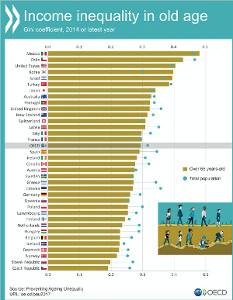
Chart: OECD Income Inequality in Old Age
Click to enlarge
Inequality begins at an early age, according to the findings. For example, a 25-year old university educated man may live almost eight years longer than his less educated peer, on average across countries; for women the difference is almost half (4.6 years). Health impacts the ability to work and earn, the report summary indicates; and over a career, poor health reduces lifetime earnings of low educated men by 33 percent and 17 percent for highly educated men.
In the United States, health problems also contribute to increasing inequality, according to the country report summary. It indicates that Americans are far more unhealthy than their peers in other countries; that people from low socioeconomic backgrounds are affected by bad health more than those from high socioeconomic ones; and that this is demonstrated by the large life expectancy gaps between high and low educated groups.
Disabilities, depression and obesity are widespread, according to the report. More than one third of American adults are obese, more than in any other OECD country. The report proposes that the authorities institute policies to target vulnerable groups as early in life as possible to prevent health, labor market and other socioeconomic disadvantages.
Preventing Ageing Unequally, published October 18, 2017, examines the development and interaction of two global mega trends of population, aging and rising inequalities, within and across generations. According to the website description, the report has 13 tables and 120 charts, shows how inequalities in education, health, employment and earnings compound, resulting in large differences in lifetime earnings across different groups; and suggests a policy agenda to prevent, mitigate and cope with inequalities. The OECD, working with over 100 countries, is a global policy forum with a mission to promote policies to improve the economic and social well being of people around the world.
Posted by Elena del Valle on December 7, 2016

According to Mintel, consumers are most likely to be interested in products with vitamin C, fruit based ingredients, oatmeal, and honey.
Photo: HispanicMPR.com
Last year, facial skin care and anti-aging cream sales declined after experiencing steady growth for years in the past, according to research company Mintel. Although anti-aging products remains the largest segment in the category, it suffered a sales decrease of 6.3 percent from 2014 to 2015. Also, 21 percent of consumers who responded to a Mintel survey said they do not use and are not interested in using anti-aging products compared to 18 percent of consumers who use them.
The overall facial skincare and anti-aging market experienced a 1.4 percent decrease in sales in 2015, falling to $6.6 billion, according to Mintel. Baby Boomers, consumers 55 and older, who took the research company’s survey were the least likely to report usage of nearly every facial skincare product they surveyed, with one third (32 percent) not using any of the surveyed products compared to 19 percent overall.
“While the facial skincare category has experienced tepid sales over the years, in 2015 we saw declines for the first time in five years,” said Shannon Romanowski, category manager, Health, Household, Beauty and Personal Care at Mintel, in a press release. “Moving forward, the category’s success will rely on younger consumers and the growing facial cleanser segment, with an emphasis on natural, recognizable ingredients and innovation like ‘waterless cleansing.’ To broaden the appeal of these products, brands should be proactive in addressing concerns surrounding cost and usage instructions.”
According to Gastronomia Global Beauty and Personal Care Trend, a Mintel survey of 1,613 adults who said they use skincare products, consumers are interested in milder, natural formulations that shield against pollution. One in seven (14 percent) of the respondents believe pollution impacts the appearance of their skin.
Survey takers also said they view lifestyle as an important factor in their skin’s appearance. Many said they are convinced hydration (44 percent) and diet (36 percent) impact skin’s appearance more than using skincare products (26 percent). Another 38 percent said they believe stress impacts the appearance of their skin. Among the survey takers 30 percent said they seek anti-aging products making anti-stress claims.
“Consumers are embracing healthy, holistic living, and our research shows that these lifestyle changes are driving the facial skincare and anti-aging market. In such a saturated marketplace, products featuring natural formulations are standing out to consumers who trust identifiable and natural ingredients,” said Romanowski. “The link between diet and skin is evident, and as consumers increasingly associate their lifestyle with their skin’s appearance, product formulations with added food-based ingredients and vitamins stand out among the competition.”
According to the Mintel report, consumers are most likely to be interested in products with vitamin C (85 percent), fruit based ingredients (78 percent), oatmeal (78 percent) and honey (76 percent); and 72 percent of consumers are interested in products featuring probiotics.
Posted by Elena del Valle on August 24, 2016
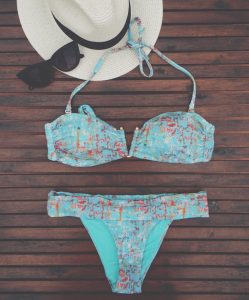
A Lumé bikini
Photos: Lumé
Paula Daza was born in Colombia and raised in the United States. As a young woman she decided she wanted to raise funds for people in her country of birth. In 2014, she founded Lumé Swimwear, a Katy, Texas based company Daza describes as “a 100 percent ethical luxury fashion brand that combines fashion, art, and giving back.” Lumé makes swimwear, beachwear, mochila bags and shoes from nylon and spandex in Medellin, Colombia and sells the vast majority, 90 percent, to customers in Europe. She hopes to grow her domestic market share.
The company, which Daza says follows fair trade practices and supports underprivileged children, offers 49 styles, including men’s trunks, ranging in price between $140 and $170 each. A page on the company website features photos of people with sewing machines in the background holding signs that say “I made your clothes” at the top. At the bottom there are photos of adults and children some of them holding toys. Lumé donates 10 percent of proceeds to the JuanFe Foundation (juanfe.org/en/). To date donations have reached $4000.
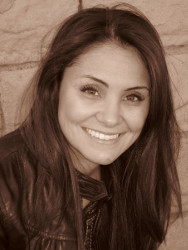
Paula Daza, owner, Lumé Swimwear
When asked about her company’s charitable donations Daza said by email via her publicist,“…and every summer I spent it in Colombia and would see the need of the people, the homeless children without shoes, the poor living in slums and it would just break my heart. I promised myself at that young age that one day I would find a way to give back to my native country in some way how ever little it may be.”
Before establishing her own company Daza worked in merchandising, buying and developing and launching other brands and designers. After many years in the fashion industry in New York City she found a path to follow through on the promise she had made herself. Overcoming a period of life changes led her to decide she wanted to start fresh by pursuing her three passions in life: fashion, art, and giving back. That in turn prompted her to establish her company.

Euphoria, a painting by Edgard Medina, served as inspiration for Lumé products.

Lumé beachwear inspired by art by Edgar Medina
To make its swimwear products Lumé transfers the original paintings of artists into prints for women who like fashion and art, seek to be unique while at the same time like purchasing items that are sustainable and eco-conscious. In exchange the artists receive a 10 percent license fee and exposure for their art. The 2016 collection features the work of two artists, including Edgar Medina whose art appears above. Medina is a Houston, Texas based abstract painter originally from Mexico.
“The process of picking artist to collaborate with is a very organic process, many artist write to us and some we have found by seeing there art work first,” Daza said when asked how she selects the artists she works with for the designs. “We also look to work wth artist that are involved in their community, it is important to work with artist that share that same vision of giving back and helping other through art. It is important for us at Lume to work with artist that are both an exceptional artist with unique work and at the same time philanthropic, because that is at the core of our co mission.”
“The reason I participate in this model is because I liked the idea to have my work in swimwear collection,” said Medina by email. “But, what made me fall in love even more is the charity work behind Lume Swimwear. A percentage of the sales goes back to a charity of choice. As an artist, I am very committed to give back to my community and help others in need through my work. I am so blessed to be able to give back to my community through my work. It is so satisfying to see the proceeds from a sale of an Edgar Medina original go to help a child with cancer, provide medical services to low-income teens or send a child with Muscular Dystrophy to camp. It is very important to me to give back to the community in honor of all that I have achieved and overcome in my own life.”
According to his bio, Medina originals have been shown across the country at galleries in Chicago, New Orleans, Santa Fe and Houston; and Medina has been a featured artist at Art Chicago, The Los Angeles Art Show, Art Santa Fe and Red Dot Miami. He works out of his studio space in Montrose within Native Citizen, which features his gallery where clients can visit him at work.
Posted by Elena del Valle on May 18, 2016

Click to enlarge
Photos: Ecosia
Ecosia, a Berlin, Germany based search engine, has between 2 and 2.5 million monthly active users who submit about 750,000 searches a day. The company’s search results and ads are powered by Bing. What makes the company special? In a world where it seems everyone is driven by greed alone, Ecosia donates 80 percent of its monthly profits ($50K to $80K each month) to planting trees in Brazil and Burkina Faso. Where the search engines keep track of users and their habits, Ecosia doesn’t.
“We don’t engage in any long-term saving or selling of personally identifiable user data,” said, Christian Kroll, chief executive officer and founder, Ecosia, by email when asked about the company’s privacy policies. “We believe that our users’ data and their privacy should be protected.”
Most of the search engine’s users are based in the Germany, Austria and Switzerland (DACH) region, where the company has captured 10 percent of non-Google users, followed by France and Spanish speaking countries, according to Kroll. Going forward he and his colleagues see the biggest potential in English speaking markets, and hope to eventually capture 2 percent of the global search market.
“We see Ecosia as a tool that allows users to capitalize on a daily habit (in this case searching the web) and do good without any further cost or effort on their side,” said Kroll. “We want to inspire others to come up with more business ideas like that and encourage them to use a share of their profits to support a good cause by proving that it’s actually possible.”
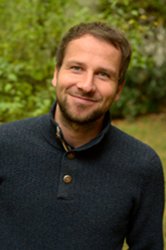
Christian Kroll, chief executive officer, Ecosia
“I decided to move to Berlin because it was closest to my family and offered (and still does) great opportunities for tech and green start-ups,” he said when asked about his choice of base. “The rent is very affordable, there are many creative and highly talented people from all over the world and people generally seem very open to topics like sustainability and shared economy.”
The entire Ecosia team is based in Berlin. There are 15 people, most of them full-time workers. Kroll founded the company in 2009 after traveling extensively. Despite several attempts it was not possible to speak with Kroll by phone in time for the publication of this note. Long term, the company aspires to plant 1 billion trees and end deforestation.
Posted by Elena del Valle on February 18, 2016

Apple Watch
Photo: Apple
Less than a month after I bought a new Swiss made watch it stopped working. I contacted the manufacturer per the warranty instructions to discover the company had been purchased by another watch seller. Dozens of calls, emails and faxes and a month later I’m still waiting for my repaired watch to arrive. As I think of replacement options and future purchases a smartwatch has crossed my mind. If a traditional watch under warranty was such a hassle what would a smartwatch offer?
Thinking of acquiring your own bit of wrist software bling? If you plan to buy a smartwatch you will be among 6 percent of Americans who own one, according to Watches and Jewelry US, September 2015, a report by Mintel. Researchers at the company believe by 2020 sales of traditional and sport watches could suffer since 21 percent of survey respondents who bought a watch in the previous year said they were very interested in the smartwatch trend. Among men between 18 and 34 years old 37 percent said they were interested.
“There is a very real possibility that smartwatch sales could cannibalize sales of other watches over the next five years,” said Diana Smith, senior research Analyst, Retail & Apparel at Mintel. “This scenario assumes that the current smartwatch buzz manifests into sales that can withstand momentum as more functional apps are created, more developers launch new products and prices come down. It also assumes that sport watches continue to grow in light of consumers’ heightened interest in using them to track their fitness levels and compete against others in various forms of exercise. An ideal situation for the smartwatch sector would be one where smartwatches (and sport watches) lift the entire category, while traditional watches – which comprise the majority of total watch sales – remain at least steady.”
U.S. retail sales of watches and jewelry may have been $79.3 billion in 2015, up 1.6 percent over the previous year. Slow growth may continue through 2020 to reach a combined total of $88.6 billion, and Mintel researchers believe watch sales will reach $9.5 billion in 2015, gaining 2 percent over 2014. Based on an estimated growth rate of 4 percent year-over-year (YOY), the market could reach $11.5 billion by 2020.
It is worth noting that traditional watches were favorites among respondents to the Mintel survey, where 31 percent of men and 30 percent of women preferred them. Among the survey takers 25 percent, including 32 percent of older Millennials (consumers aged 29-38), said they buy watches mainly as a fashion statement
Posted by Elena del Valle on February 10, 2016
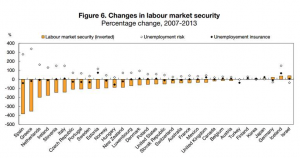
Changes in labour market security 2007-2013- click to enlarge
Chart: Organisation for Economic Co-operation and Development (OECD)
How is your job satisfaction? If your answer is average, it is not surprising. If the quality of your employment declined in the past 10 years you are not alone. What makes a good job and how do individual countries measure in that category? Seeking to answer these questions the Organisation for Economic Co-operation and Development (OECD) examined job quality from the following perspectives: Earnings quality, job market security and work environment quality.
For earnings the organization’s researchers looked at earnings and their distribution across the workforce. For job market security they examined the risk of unemployment and its expected duration. When considering the quality of the working environment they looked at the incidence of demands and resources and the combined potetntial of high demands and low resources that result in job strain.
The best performing countries are Australia, Austria, Denmark, Finland, Germany, Luxembourg, Norway, and Switzerland. They are followed by Belgium, Canada, Czech Republic, France, Ireland, Israel, Japan, Korea, Mexico, Netherlands, New Zealand, Slovenia, Sweden, United Kingdom, and United States display with average performance. That means than when examining the three job quality measures, they countries display no more than one outcome in the top-10 or the bottom-10 of the ranking. At the bottom of the list are Estonia, Greece, Hungary, Italy, Poland, Portugal, Slovak Republic, Spain and Turkey.
The OECD data also reveal significant differences across groups of workers. Young and unskilled workers generally have the worst performance in terms of employment and have lower earnings and considerably higher labour market insecurity and higher job strain than other segments. Women’s employment rates are much higher than men’s while at they are paid far less than their male counterparts. On the up side, they are less likely than men to suffer from job strain.
Job quality dropped in the past decade. The crisis affected the number of jobs and their quality. Earnings quality decreased in two thirds of the OECD countries, especially in Greece and the United Kingdom; job market security worsened in most OECD countries, especially in Spain and Greece.
The mission of the OECD is to promote policies that will improve the economic and social well-being of people around the world. The organization, based in Paris, France, was established in 1961. It has 34 member countries, 2,500 staff and a budget of 363 million euros.
Posted by Elena del Valle on January 20, 2016
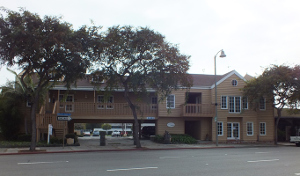
The StockPKG office is in Dana Point, California
Photo: StockPKG
While some speculate and worry about another recession, the management of StockPKG, a Dana Point, California discount business supply company founded in 2012, is hoping for triple digit growth. That was the growth the company experienced in the previous three years. To further the likelihood of such growth the company plans a catalog launch in March and hired Driven PR, an integrated marketing communications company.
The distributor plans to add 35,000 products in 2016, totaling 75,000 in all, as well as offering educational and consulting resources for those looking for assistance when starting or growing their business. The company has 25 employees and foresees growth in the sales and customer service teams. By the end of 2016, the company expects to have a national network of up to 75 employees.
“Our mission is to be a one-stop-shop for all business supply and flexible packaging needs for businesses and customers all over America,” said Sean Rudner, owner and president of the company, by email via a Driven PR representative. “We offer consulting services to businesses with complex packaging needs who may not know where to go or how to best service their customers. StockPKG’s customer service representatives are educated and always available to consult with businesses about their packaging options. We genuinely care about our customers and are passionate about seeing their businesses grow.”
The top sellers are Shipping Mailers, Clear Stand Up Pouches and Stretch Wraps. In addition to StockPKG’s online marketplace, the company offers consulting services to businesses with complex packaging needs. Powered by Global Plastic Supply, the company serves businesses nationwide through its website, by phone or in person.
Posted by Elena del Valle on January 4, 2016
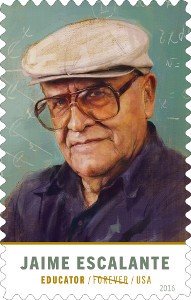
Jaime Escalante US stamp
Photo: United States Postal Service
Following the recommendation of its Citizens’ Stamp Advisory Committee, the United States Postal Service will issue a self-adhesive Forever Stamp to honor Bolivian born educator Jaime Escalante, probably in the summer of 2016. December 31, 2015 would have been his 85 birthday.
Press materials from the Service describe Escalante as a “beloved and charismatic California educator (who) used unconventional methods to inspire his inner-city students not only to learn calculus but also to pass Advanced Placement tests in the subject. With his colleagues at Garfield High School in East Los Angeles, he proved that students judged to be ‘unteachable’ could master even the most difficult subject.”
The design of the stamp with a 49 cent price features Escalante in a digital illustration meant to resemble an oil painting. The illustration is based on a 2005 photograph taken by Jaime W. Escalante in a classroom where his father had taught. The average print run for Forever stamps is in the 20 to 30 million range. The print quantity for the Jaime Escalante Forever Stamp has not been announced. The Postal Service is promoting the stand alone stamp (not part of a collection) through print, TV and broadcast as well as mainstream media, Hispanic media and social media.
“There is no advertising budget,” said Roy Betts at the U.S. Postal Service Corporate Communications office via email. “The Postal Service typically promotes new stamps through media channels and in-store retail messaging in local Post Offices.”
Born to schoolteachers in La Paz, Bolivia Escalante learned to teach by trial and error and by imitating the methods of teachers he had admired as a student. In 1961, Escalante spent a year in the United States as part of President John F. Kennedy’s Alliance for Progress, a program to improve relations between the United States and countries in South America. As part of the program, Escalante attended classes in Puerto Rico and traveled to schools around the country to study their methods.
In 1963, Escalante received his immigration visa and arrived in the United States. He came alone, planning to find a job and housing and then send for his family. Because of his limited English, he had difficulty finding employment. Eventually, he found a job mopping floors in a restaurant, enrolled at Pasadena City College, and brought his wife and son to California. Since his Bolivian teaching credentials did not transfer to the United States he had to start his education from the beginning.
He received his bachelor’s degree in mathematics from California State University in 1973 and then won a prestigious National Science Foundation scholarship, which allowed him to study full time and earn his teaching credentials a year later. He quickly found a job at Garfield, a school in crisis with high dropout rates and gang violence, and in jeopardy of losing its accreditation.
Fame came to Escalante in an unexpected way when in 1982, 18 of his students took the Advanced Placement (AP) Calculus Exam. After they, Mexican Americans from a low-income area of Los Angeles, all passed and seven students received fives, the highest score, the ETS College Board accused 14 students of cheating and requested that they retake the exam. Twelve of the 14 did, and all passed the second exam, a different version from the first.
Their story made the national news, making him and his class instant heroes and led to the making of the movie Stand and Deliver. That same year, publication of Escalante: The Best Teacher in America, a book by Washington Post reporter Jay Mathews, brought him additional acclaim. Later Escalante showed how math is used in real life as part of the Public Broadcasting Service (PBS) series Futures. In 1988, Escalante won an award from the Hispanic Heritage Foundation. In 1999, a year after he retired from teaching he was inducted into the National Teachers Hall of Fame. He died on March 30, 2010.
The Citizens’ Stamp Advisory Committee is a group of private citizens with “a passion for American history and a love of stamps, who are appointed by the Postmaster General of the United States.” They are: Gail Anderson, partner, Anderson Newton Design; Peter Argentine founder, Argentine Productions; Justin Bua, artist and creator of genre known as “distorted urban realism;” B. J. Bueno, founder, The Cult Branding Company; Cheryl R. Ganz, author; Henry Louis Gates, Jr., Alphonse Fletcher University Professor, W.E.B. Du Bois Institute for African and African-American Research, Harvard University; Janet Klug, chair, Philatelist; Carolyn Lewis former chief executive of Texwood Furniture Inc; Harry Rinker, antiques and collectibles appraiser; Maruchi Santana, founder, The Brand Extension Katherine C. Tobin, Ph.D., commissioner, U.S. – China Economic and Security Review Commission; and Donna de Varona, TV sports commentator.
Posted by Elena del Valle on January 1, 2016

As the New Year begins we take this opportunity to wish you the best for 2016 and thank you for visiting and following us in 2015.
Posted by Elena del Valle on December 9, 2015

Millennials have a higher preference for fresh produce than non-Millennials.
Photo: HispanicMPR.com
As older generations decline Millennials are growing and are expected to continue growing over the next five years. Millennials represent one quarter of the population of United States, making them the largest generation at present. At the same time Millennials are highly diverse as a generation. Among Millennials 21 percent is Hispanic, according to Mintel, a data and market research company.
Divided into younger and older Milennials this generation is marrying later, saving money, going to school and or starting a family. They shop differently, like different products, and have different attitudes about food than previous generations, and their income ranges from below average to about average, according to The Millennial Impact: Food Shopping Decisions US, September 2015, a Mintel report.
A Mintel survey indicates that only 47 percent of Older Millennials and 35 percent of Younger Millennials surveyed said they trust large food makers. Among older millennial’s 77 percent wish food manufacturers were more transparent about how they make their products while 70 percent of their younger contemporaries said they wish the same thing. Among non-Millennials 69 percent wished food makers were more transparent about the product that they make.
Millennial’s like shopping for groceries and specialty stores and online, and according to Straight to You, a Mintel Trend, they prefer that products be delivered to them. Both younger and older Millennials have a higher preference for fresh produce than non-Millennials.
























